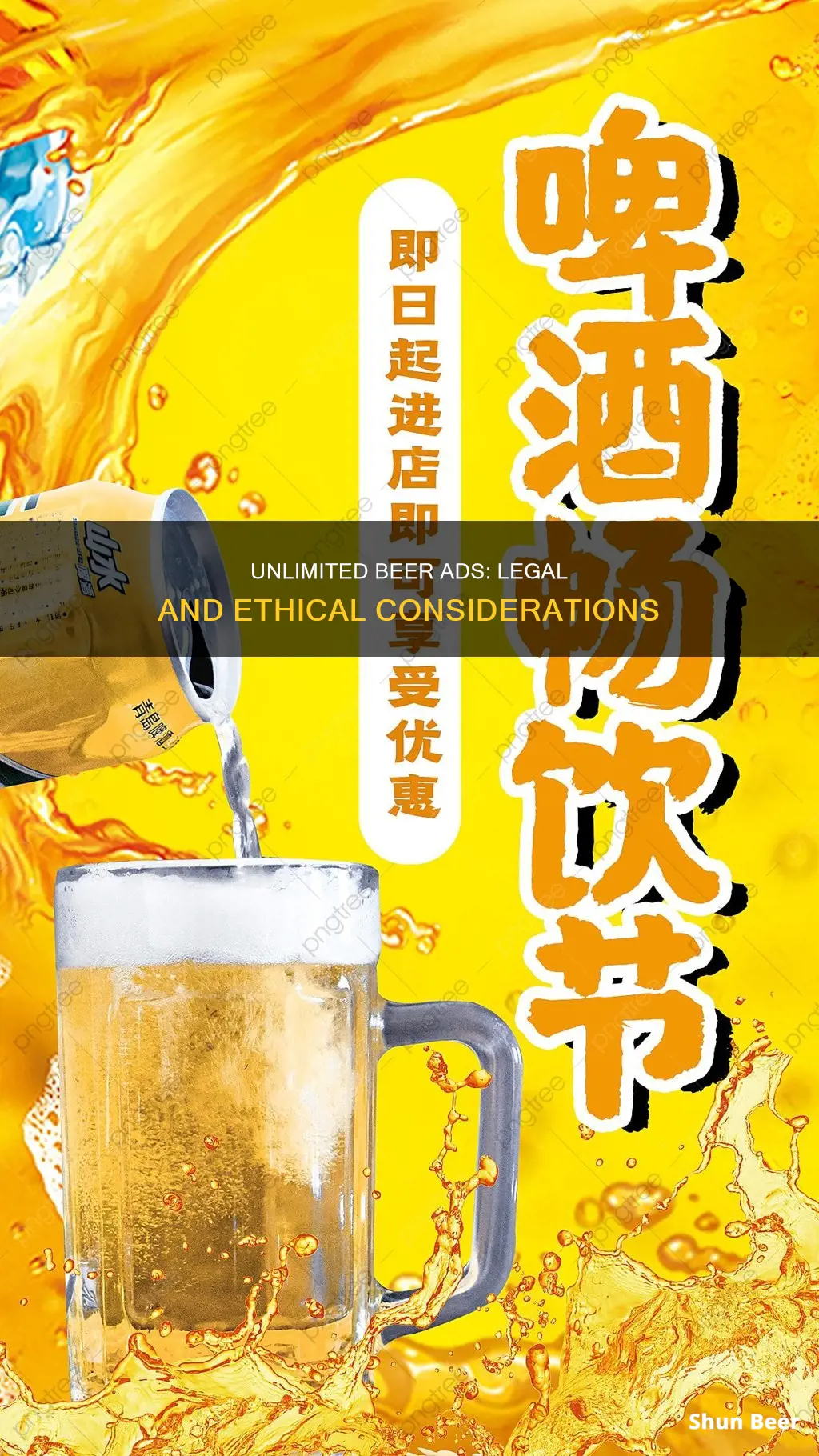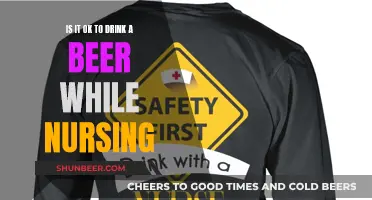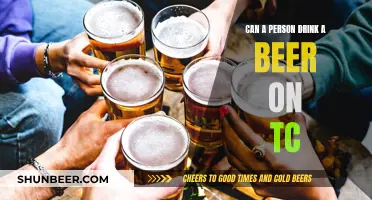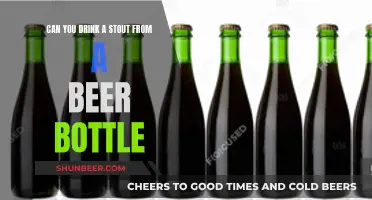
Alcohol is a lucrative industry, with billions spent on advertising and marketing. However, the promotion of alcoholic beverages is a sensitive issue due to the potential for misuse and abuse, especially among minors. While the First Amendment protects freedom of speech, regulations exist to ensure responsible advertising. In the United States, the Federal Alcohol Administration Act (FAA) governs alcohol advertising, with specific requirements for different types of beverages. Beer advertisements, for example, must include the class of the product (e.g., ale, lager, etc.), the advertiser's name and address, and other specific details.
One notable aspect of beer advertising is the unwritten rule that people are not shown drinking the beverage on camera in commercials. While there is no federal law prohibiting this, television networks have long-standing self-imposed regulations that advertisers must adhere to to get their commercials aired. This practice is not universal, as some countries like Australia and Germany do allow the depiction of alcohol consumption in their ads.
What You'll Learn

Advertising regulations for beer
In the United States, the marketing and advertising of beer and other alcoholic beverages are regulated under the Federal Alcohol Administration Act (FAA) by the Tobacco Tax and Trade Bureau (TTB), which is hosted by the Department of the Treasury.
The First Amendment allows for freedom of speech, which limits the federal government's ability to regulate advertising, even for alcohol. However, advertisements for alcoholic products must be truthful and without deception. They must provide enough information about the product's identity for consumers to make informed decisions about what the product is and what it contains.
The TTB does not require pre-approval of advertisements but offers a free voluntary pre-screening service for industry members. The TTB reviews complaints to ensure compliance with rules and regulations and also conducts independent reviews of advertisements.
Specific information is required in advertisements for malt beverages and beer, including the class of the product (e.g. ale, stout, lager), the name and address of the advertiser, the type and class of the product, and the alcohol content listed as a percentage by volume.
There are also prohibited practices for alcoholic advertisements, including misleading statements, obscene representations, misrepresenting analyses, guarantees, and claims about health benefits or government supervision.
Promotions and discounts for alcoholic beverages are popular, but establishments must comply with state regulations. For example, daily drink specials are typically limited to one type of alcoholic beverage per day, and happy hours may be restricted in duration. Free drink promotions and contests that encourage binge drinking are prohibited.
Additionally, regulations aim to prevent the marketing of alcohol to underage individuals. Alcoholic beverage companies and the advertising industry agree to self-regulatory standards to discourage underage drinking based on ad placement and content. These regulations include avoiding targeting audiences with a high percentage of underage individuals and not placing physical advertisements near schools, playgrounds, or churches.
UK Beer Laws: Drinking While Driving
You may want to see also

Self-regulation by TV networks
In the United States, the marketing and advertising of alcoholic beverages are regulated under the Federal Alcohol Administration Act (FAA) by the Tobacco Tax and Trade Bureau (TTB), hosted by the Department of the Treasury. While the First Amendment allows for freedom of speech, advertisements for alcoholic products must be truthful and without deception. They must also provide enough information about the product's identity for consumers to make educated decisions.
The TTB does not need to approve ads before they are placed or broadcast, but it does offer a free voluntary pre-screening service for industry members. The TTB reviews complaints from government agencies, the public, and industry members to ensure compliance with set rules and regulations. Additionally, market compliance specialists within the TTB independently review advertisements for compliance.
Specific information is required in advertisements for wine, distilled spirits, and malt beverage products, including the name and contact information of the advertiser, the class and type of the product, and the alcohol content (for distilled spirits and malt beverages). Consumer specialty items, such as t-shirts or bumper stickers, are only required to display the company or brand name.
While the TTB sets these standards, self-regulation plays a significant role in the alcohol industry. The Federal Trade Commission (FTC) has encouraged the industry to adopt and comply with self-regulatory standards to reduce the extent to which alcohol advertising targets underage individuals. This is a significant concern, as alcohol is the most widely used drug by American youth, and underage alcohol use has serious health and social implications.
The alcohol industry has responded with voluntary self-regulatory codes intended to prevent advertising and marketing that appeals to underage consumers. These codes include prohibiting blatant appeals to young audiences and advertising in venues where most of the audience is under the legal drinking age. The FTC regards self-regulation as particularly suitable in this area, as government restrictions on advertising could raise First Amendment issues.
Three major alcohol supplier trade associations—the Distilled Spirits Council of the United States (DISCUS), the Beer Institute (BI), and the Wine Institute (WI)—have voluntarily adopted regulations to discourage underage drinking. Alcohol advertisers generally agree to not appeal to an audience under the age of 21 and to limit underage audiences to no more than 28.4%. They review demographic data to ensure that 70% or more of the audience is of legal drinking age and avoid placing physical advertisements near schools, playgrounds, churches, or other areas with high underage traffic.
To further strengthen self-regulation, the FTC has recommended the creation of independent external review boards to address complaints and improve compliance. They have also suggested raising the standard for the legal-age audience for ads beyond 50%, as the current standard allows alcohol advertising to reach large numbers of underage consumers.
Beer and Melatonin: A Safe Mix?
You may want to see also

Rules for online alcohol advertising
The following rules and regulations for online alcohol advertising are based on US federal laws and self-regulatory guidelines from the alcohol industry. Other countries and regions may have different or additional rules, so it is important to consult the relevant local laws and guidelines when advertising alcohol in those markets.
Federal Regulations
Alcohol advertising in the US is regulated by the Federal Alcohol Administration Act (FAA) and enforced by the Tobacco Tax and Trade Bureau (TTB). However, in practice, the TTB relies on self-regulation by the alcohol industry based on guidelines from the three major alcohol supplier trade associations: the Distilled Spirits Council of the United States (DISCUS), the Beer Institute (BI), and the Wine Institute (WI).
The TTB's federal regulations for alcohol ads include requirements for what information must be included in advertisements and where they can be placed, among other things. These regulations vary depending on the type of alcohol being advertised, with wine, malt beverages, and distilled spirits each having its own set of rules.
Self-Regulatory Guidelines
The Beer Institute, DISCUS, and Wine Institute have all adopted voluntary advertising and marketing codes that are periodically reviewed by the Federal Trade Commission (FTC). These codes include guidelines designed to reduce the likelihood that alcohol advertising will target consumers below the legal drinking age.
- Digital marketing communications are intended for adults of legal purchase age (21 years or older in the US).
- Digital marketing communications should only be placed in media where at least 70% to 71.6% of the audience is of legal purchase age.
- Digital marketing communications that involve direct interaction with a user should require age affirmation prior to engagement.
- User-generated content on a site or page controlled by the brand must be monitored and moderated regularly.
- Digital marketing communications that are intended to be forwarded by users should include instructions that the content should not be forwarded to individuals below the legal purchase age.
- Digital marketing communications must respect user privacy.
Prohibited Practices
In addition to the above guidelines, there are certain practices that are generally prohibited in alcoholic beverage advertisements:
- Statements that are misleading, false, or untrue.
- Saying something negative or disparaging about a competitor.
- Indecent or obscene representations, designs, or statements.
- Misrepresenting analyses, standards, or tests.
- Guarantees that are misleading, excluding money-back guarantees.
- Statements falsely claiming health benefits from alcohol consumption.
- Claims that alcohol is made, sold, or marketed under federal or state regulation.
- Using the word "bonded" or implying that alcohol is made under government supervision.
- Claims that wine or malt beverages contain distilled spirits.
- Statements about distilled spirits being "double" or "triple" distilled unless they are true.
- Using the word "pure" when advertising distilled spirits, unless referring to a specific ingredient.
- Statements that are not consistent with approved labeling.
Beer Foam Stones: Do They Work?
You may want to see also

Irresponsible alcohol advertising
Advertising "all you can drink beer" can be considered irresponsible and may be banned for several reasons. Firstly, it may encourage excessive and irresponsible consumption of alcohol, which can lead to anti-social behaviour, alcohol-related violence, and adverse health effects. Such promotions are likely to be banned in licensed premises and may result in the suspension or cancellation of a liquor licence.
Advertising alcohol must comply with various regulations, such as the Federal Alcohol Administration Act (FAA) in the US, which is regulated by the Tobacco Tax and Trade Bureau (TTB). These regulations aim to prevent misleading, false, or indecent statements and claims about health benefits. The TTB reviews complaints and independently reviews advertisements to ensure compliance.
In addition, alcohol advertisements must not target minors or individuals below the legal drinking age. This includes avoiding placement near schools, playgrounds, and churches and refraining from using images or marketing ploys that may appeal to younger consumers.
When it comes to "all you can drink beer" promotions, establishments may face restrictions on offering unlimited drinks for a fixed price. Such promotions may be prohibited by state regulations to prevent excessive consumption and encourage responsible drinking.
Furthermore, "drink responsibly" messages in alcohol advertisements have been criticised for being ineffective and deceptive. While these messages are commonly included in ads, they often lack a clear definition of responsible drinking and fail to provide warnings about the risks associated with alcohol consumption.
To summarise, irresponsible alcohol advertising related to "all you can drink beer" promotions can have negative consequences and is subject to strict regulations. Establishments must be mindful of the potential impact on public health and safety and adhere to the relevant laws and industry standards to avoid penalties and contribute to responsible drinking practices.
Recovering Alcoholics and Ginger Beer: Is It Safe?
You may want to see also

Alcohol advertising and underage drinking
Alcohol advertising and its impact on underage drinking is a complex and multifaceted issue that has been the subject of extensive research and debate. While the alcohol industry maintains that there is insufficient evidence to establish a direct link between advertising and underage drinking, studies suggest otherwise. Here is an examination of the topic through four to six paragraphs:
Underage drinking is a significant public health concern in the United States, with alcohol being the most widely used drug by American youth. The alcohol industry spends billions of dollars on advertising and promotion, and young people are a key target audience for their efforts. This marketing includes not only traditional advertisements but also sponsorships, internet advertising, product placement, and other means. The intensity and complexity of alcohol marketing, coupled with the use of cutting-edge technologies, have created an environment where youth are overexposed to alcohol advertisements.
Research has established a positive correlation between alcohol advertisements and underage drinking. Studies have shown that the more ads youth are exposed to, the greater the likelihood of them initiating drinking and increasing their alcohol consumption. This is especially true for youth who already have drinking experience. Certain types of ads, such as in-store displays and ads in magazines and at concession stands, have been found to have a stronger influence on youth. Additionally, youth as young as nine years old recognize specific beer ads on television, indicating that they are not immune to the persuasive appeals of TV advertisements.
To counter the impact of alcohol ads on youth, school drug prevention programs have been shown to be effective. The RAND Corporation's Project ALERT and ALERT Plus curricula, which help students identify and resist alcohol marketing strategies, have been found to reduce the likelihood of students drinking. These programs also make students less susceptible to the persuasive appeals of certain types of alcohol ads.
The alcohol industry has voluntary guidelines that prohibit content that primarily appeals to youth. However, these guidelines have been criticized as vague and unenforceable. Additionally, the industry's self-regulatory guidelines do not adequately address the issue of content that may be more persuasive to younger audiences. Research has shown that alcohol brands with youth-appealing advertising are consumed more often by youth than adults, indicating that these ads may be targeted towards relatively younger audiences.
To protect youth from the influence of alcohol advertising, policymakers should consider regulating all ad venues to which adolescents are exposed. Given the high rates of beer advertising awareness among adolescents watching televised sports, the practice of airing frequent beer ads during such programming should be re-evaluated. Additionally, youth reactions to specific ads should be regularly monitored to identify and remove ads with particular appeal to young people. Further research is needed to understand the cumulative effects of exposure to TV alcohol ads over time.
Beer and the Mediterranean Diet: What's Allowed?
You may want to see also
Frequently asked questions
Advertising alcoholic beverages is legal, but there are regulations in place to ensure the responsible advertising of these products.
The Federal Alcohol Administration Act (FAA) regulates the marketing of alcoholic beverages in America. While the First Amendment allows for freedom of speech, advertisements for alcoholic products must be truthful and without deception. They must also include specific information about the product, such as the class, type, and alcohol content. Additionally, there are prohibited practices that alcoholic beverage advertisements must avoid, including misleading statements, negative comments about competitors, and indecent representations.
While there is no federal law or FCC regulation prohibiting the depiction of alcohol consumption in advertisements, it is generally frowned upon by television networks due to self-imposed industry standards. As a result, most beer commercials do not show people drinking the product.
Yes, country-specific restrictions may apply. For example, Google's advertising policies mention that they don't allow certain kinds of alcohol-related advertising and that any ads containing irresponsible alcohol-related content will be disapproved. This includes targeting minors, implying improved social or professional standing from drinking, or portraying excessive drinking favorably.
Yes, there may be state regulations regarding promotions for alcoholic beverages. For example, daily drink specials may be limited to one type of alcoholic beverage per day, and happy hour may be restricted to a certain number of hours per day or week. Additionally, establishments may not offer free drinks as incentives or attempt to induce people to purchase alcohol through promotions.







